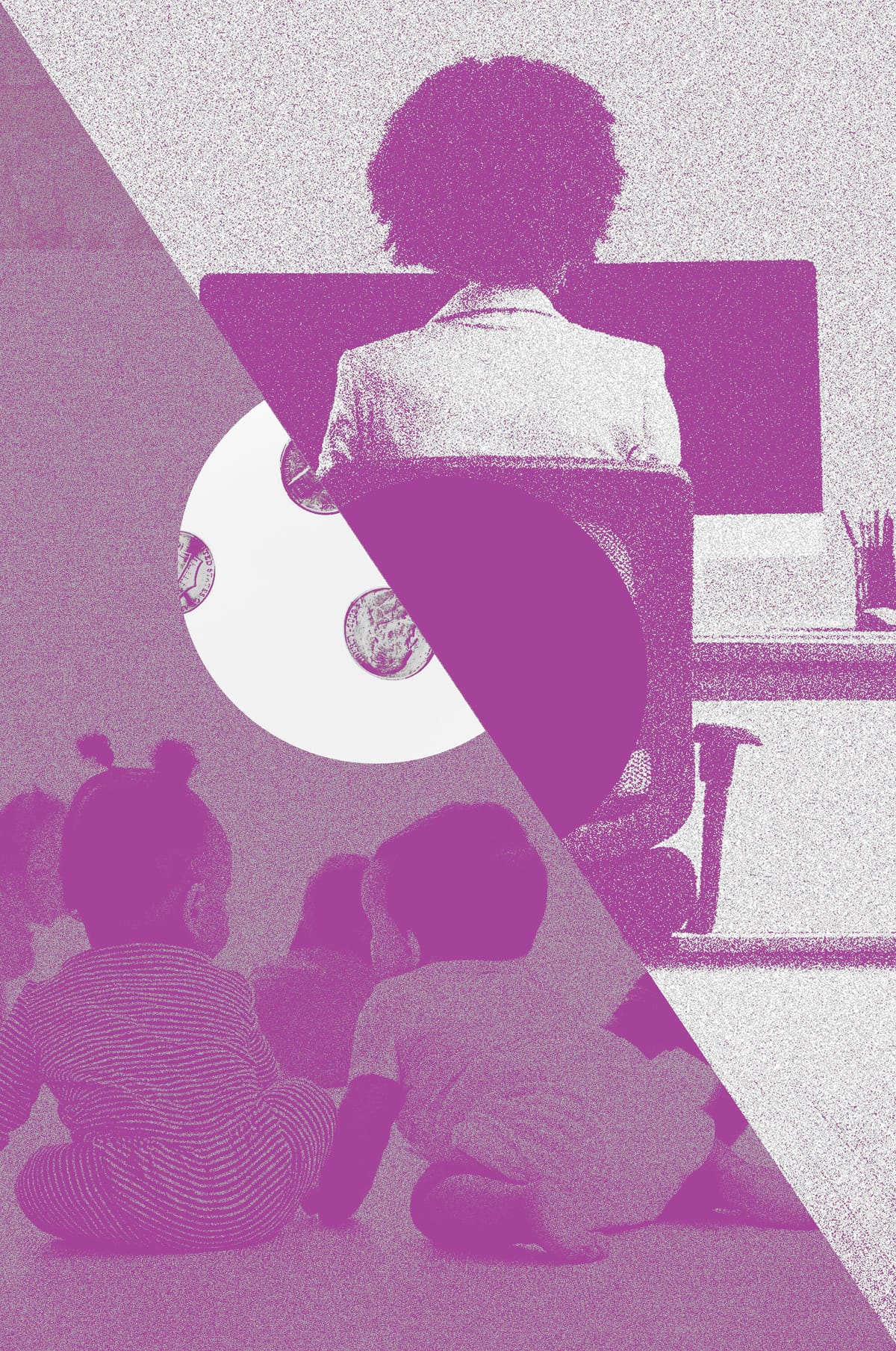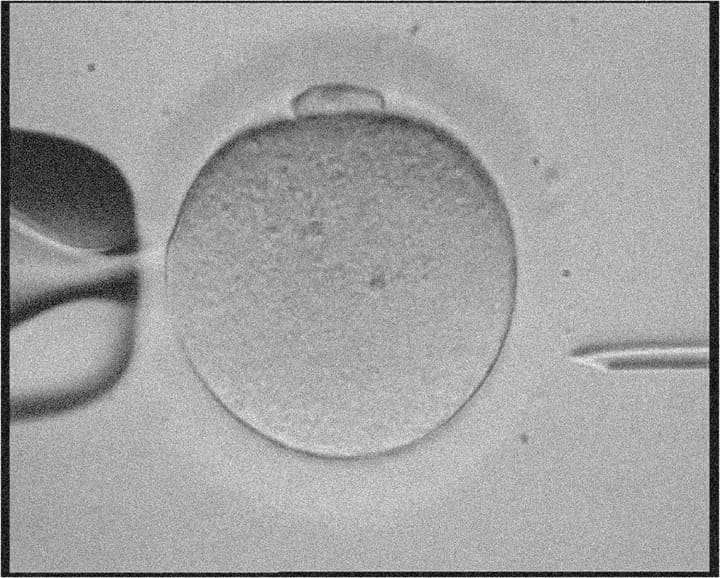The insistence on “affordable daycare” as a viable solution to the problem of childcare reveals a consistent devaluation of gendered labor. It might also negatively impact children themselves.
Last March, in the highest “no” vote in their nation’s history, Irish voters rejected a proposal that would have removed gendered language from the island’s “Cares Act.” The referendum, which codifies the Irish state’s economic commitment to mothers, was criticized by some for being “old fashioned.” To the majority of Irish voters, however, keeping the act’s gendered, supposedly sexist language—for example, the amendment declares that Irish women’s primary responsibilities occurred “within the home”—was important, because it ensured that Ireland would continue to value labor performed by women, specifically mothers. Irish women, after all, spend more than twice as much time on caring and housework than their male counterparts. It turns out Irish voters are less concerned with what ought to be the case—gender parity in language and in life—and more concerned with recognizing what is: the fact of gendered labor performed primarily by women.
Americans, for our part, could be so lucky. In Ireland, laws like the Cares Act ensure that the decision to stay at home, raise a family, or to return to work is just that: a decision. In the United States, by contrast, the choice to stay home or go to work is hardly a choice at all. Here, mothers are stuck between the Scylla of losing an income and living in relative social isolation as a stay-at-home-mom and the Charybdis of leaving one’s young child to work, which usually means shelling out for expensive childcare that can cost upwards of $36,000/year. (In 2023, the median annual salary for an American was around $59,000.)
Predictably, in the United States, about two-thirds of new moms return to work shortly after giving birth. According to a 2012 study from the U.S. Department of Labor, 25% of mothers return to work within two weeks of childbirth, usually because their jobs don’t provide leave or because they fear the economic consequences of not working. College graduates fare a bit better—they secure about six weeks of leave, though this absence is often unpaid. The Family and Medical Leave Act, which officially allocates 12 weeks of unpaid leave for new mothers, and which the US Congress passed over thirty years ago, is not much of a help: numerous stipulations mean that 59% of working mothers are ineligible for the program. For these reasons, about 62% of American children under the age of 5 are enrolled in center-based care, and that figure would be even higher if it included home-based daycares or those situations that include some mixture of daycare, nannies, or other non-parent care. For comparison, only 35.5% of pre-Kindergarten German children are in daycare.
In the past several decades, the Left has embraced the demand for affordable daycare, which has replaced demands for robust, paid, and extensive maternity leave policies that protect women’s jobs or, alternatively, afford them real opportunities to leave the workforce, even if for only for a few years. Given this reality, and given the Left’s insistence that daycare is a viable solution to the problem of childcare, it’s worth asking whether the practice of separating children from their primary caregivers—usually, if not always, mothers—is the panacea so many believe it to be, or if it instead reveals a consistent devaluation of gendered labor that might also negatively impact children themselves.
Scholarly analysis often suggests that daycare can have adverse effects on not only children, but mothers as well. In her cross-cultural research on multiple caregiver arrangements, Leiden University’s Judi Mesman explains that while children can, and perhaps should, have multiple caregivers and form multiple attachments, these connections are derivative of the baby’s primary attachment, which is usually to its mother. As Mesman observes, even when a child is cared for by a proverbial “village,” in the healthiest situations the child’s mother is almost always nearby, which affords the child a touchstone with whom they can regularly check in and a font from which they derive the confidence to explore and connect with others. Moreover, as Mesman elucidates, the best situation for young children is when all of their caretakers are deeply invested in the baby’s lifelong wellbeing.
With its notoriously high turnover, low pay, and high child-to-caretaker ratio, daycare is typically anathema to the family-centered model of childcare. Studies routinely find that children separated from their mothers in the first years of their lives experience higher levels of stress, which can contribute to myriad social and behavioral problems down the line. In her book Being There: Why Prioritizing Motherhood in the First Three Years Matters, Erica Komisar, a social worker and psychoanalyst, argues that there is a direct connection between the recent rise of social and psychiatric disorders and the lack of time granted to mothers and babies to foster a secure attachment in the latter’s infancy and toddlerhood.
The evidence seems to bear out this claim—or, at the very least, it appears that there is a correlation between the rise of daycare enrollment, which has more than doubled since the 1990s, and the rise of social and psychological disorders. A study from 2018 found that 1 in 6 children between the ages of 2 and 8 have been diagnosed with a mental, behavioral, or developmental disorder. In 2011, researchers found a 400% increase in prescription antidepressant use among children over the age of 12. A 2024 study discovered that hospitalizations of children under 12 suffering from eating disorders rose 119%, while a Center for Disease Control brief from that same year reported that 11.3% of children between the ages of 5 and 17 have been diagnosed with ADHD, and two-thirds of those children are on stimulants. Although these ills cannot and should not be laid solely at the feet of daycare, research continually suggests links between daycare enrollment and emotional and behavioral problems.
Mothers don’t seem to be doing much better than their kids. A recent meta-analysis of twenty-three papers that explored the relationship between maternity leave and postpartum depression concluded that the latter was more prevalent in working mothers than in their stay-at-home peers. The study also found that longer, paid maternity leaves were linked to reduced postpartum depression, fewer instances of severe postpartum, and a decreased risk of developing depression later in life. And postpartum depression’s harms are not limited to the mother. The children of depressed mothers show higher instances of mental health disorders, cognitive dysfunction, and learning disabilities. The data is clear: allowing new mothers to bond with their babies is better for the mothers, is almost certainly better for their children, and thus, in the medium and long terms, it is better for the public.
Unfortunately, these conclusions remain widely under-discussed and, when they are discussed, they’re often misrepresented. To take the most salient example, in her wildly successful trilogy of “data-driven” books for parents, the economist Emily Oster dedicates only a single chapter to helping mothers navigate the pros and cons of returning to work or remaining at home. Though Oster acknowledges that most Americans can’t afford to stay at home to raise their children, her books are aimed at those who can.
In fact, Oster seems downright child-skeptical, though she has made a mint selling books to parents. She suggests at one point that parents calculate their individual “happiness maximizing allocation” and tailor their lives to achieving it. Oster, for her part, has settled on a daily allotment of eight hours of work-time and three hours of kid-time because, she sighs, “kids are exhausting.” Predictably, this economist (who spent her early career at the famously free-market-obsessed University of Chicago economics department and business school) is a firm advocate of daycare. And to allay fears that some parents may have about sending their child to daycare, Oster turns to the data.
Relying on a 2006 study from the National Institute of Child Health and Human Development (NICHD), the most comprehensive examination of the effects American daycare has on children under the age of 4½, Oster argues that sending a child to daycare is not only comparable to raising a child at home in terms of the child’s well-being, but, potentially, even better. In her telling, children attending “higher-quality daycares correlated with better child language development”, and, she claims, children who attend daycare are no less “attached to their moms.” Oster admits that “there are small associations between behavior problems and more time in daycare at all ages,” but she nevertheless insists “that these effects are fairly minimal and all the children were in the ‘normal’ behavior range.”
Oster isn’t exactly lying, but she’s also not being entirely honest. To start, according to the study, only a small portion of facilities—ranging from 18% for children under the age of 1½ to 6% for children under the age of three—are considered “high-quality,” a nebulous appellation for daycares that supposedly afford children “positive caregiving” (quantitatively defined as the ratio of children to caregivers). In fact, the NICHD study explicitly states that “fewer than 10 percent of [daycare] arrangements were rated as providing very high quality care” and explains “that most child care settings in the United States provided care that is ‘fair.’” Put another way, the likelihood of an American mother being able to find, let alone afford, a high-quality daycare is very low. Moreover, the NICHD study plainly links time in daycare to numerous behavioral issues, from disobedience to aggression. Subsequent studies have likewise discovered that social, emotional, and behavioral problems associated with daycare can be long lasting, potentially leading to higher rates of impulsivity or risk taking and increased instances of criminal behavior, especially among boys.
It’s understandable why Oster would want to minimize daycare’s harmful effects on children. Despite her various paeans to social science and lean-in feminism, she very much knows that most mothers have little real choice regarding their children’s care arrangement. In fact, one of the most robust conclusions of the NICHD study was that both mothers and children from wealthier families fared much better when compared to those who hailed from poorer ones. In brief, the study shows that mothers who sent their children to higher-quality daycares exhibited “slightly higher levels of sensitivity” compared to mothers who sent their children to lower quality ones. Sadly, the study also reveals that the latter were “somewhat more likely to be insecurely attached” to their babies. It turns out that, shock among shocks, material conditions shape a child’s development, especially when it comes to fostering the mother-infant bond that is nearly impossible to establish in an American society that affords most new mothers only weeks off work.
Many leftists and liberals nevertheless insist that daycare is the solution to the problems raised by modern-day child rearing. One regularly hears leftists and centrists call for highly-regulated, government-backed, and affordable daycare programs. The problem, however, is that there is little evidence to suggest that universal daycare programs produce better outcomes in children. Consider this 2019 study, titled “The Long-Run Impacts of a Universal Child Care Program,” which followed the introduction of “very low-cost child care for children aged 0-4” in the Canadian province of Quebec. In effect, after the program was introduced, Quebec witnessed a “sizable negative shock” to noncognitive and health outcomes in children, in addition to providing no positive effects on their cognitive development. Alarmingly, researchers also found that the program’s attendees experienced “a significant decline in self-reported health and in life satisfaction [when they were] teens”, as well as a “sharp and contemporaneous increase in criminal behavior.”
The most positive thing the researchers discovered after conducting a meta-analysis of similar programs in Norway, Germany, Spain, the United States, and Denmark, was that universal child care had measurable benefits for “at-risk children.” But on the whole, the study indicates that universal, government-provided childcare might not be the silver bullet for which advocates are searching.
This is in no way meant as an indictment on the millions of Americans who send their children to daycare. Even in the very best situations, new parents are rarely given more than a few months with their baby or babies before they risk losing their jobs, and thus their livelihoods. And it’s not like staying at home with a baby is easy. In the increasingly child-allergic and socially alienated United States, stay-at-home parents are often left cloistered in single family homes or apartments, in car-centric towns and cities, with no government assistance and little family support (the latter, in fact, has grown worse over time, leading to a trend of so-called dead-beat grandparents).
Given that it’s far simpler to outsource care than it is to remedy society-wide alienation and gender inequality, it’s understandable that liberal centrists have settled on daycare as the de facto solution to contemporary child rearing. But it’s odd that leftists would do the same, when the far more obvious and humane answer to the problem of child rearing would be to give mothers extensive—at minimum, year-long—paid leaves and flexible return-to-work schedules. Advocating for programs like these would go a long way to getting us closer to what the Irish and much of Europe have done to acknowledge the special role mothers play in the lives of young children. This is especially important given the fact that we now know the importance to both mothers and children alike of building a secure attachment in the first months and years of a baby’s life. The Left should therefore treat paid maternity leave as seriously as it treats universal healthcare, as it is just as necessary to the well-being of the family, the state, and its citizens.
■
C. Kaye Rawlings received her PhD in Art History from Emory University.




